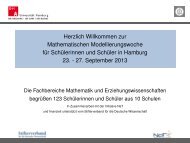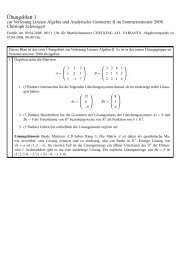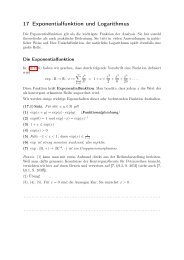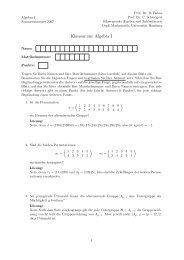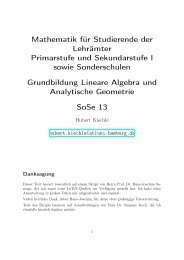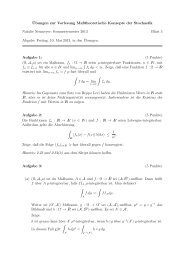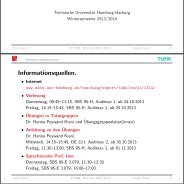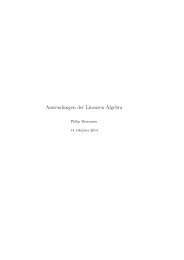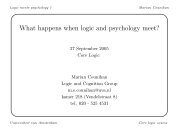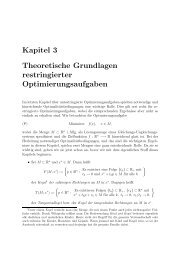pdf file
pdf file
pdf file
Create successful ePaper yourself
Turn your PDF publications into a flip-book with our unique Google optimized e-Paper software.
Proof.<br />
If H is unimodular, we have α = ɛ for the distinguished group-like element α. Then the<br />
Nakayama involution for the Frobenius structure given by the right cointegral reads by lemma<br />
3.3.9<br />
ρ(h) = 〈α, h (1) 〉S −2 (h (2) ) = 〈ɛ, h (1) 〉S −2 (h (2) ) = S −2 (h) .<br />
For the left integral, one finds ρ(h) = S 2 (h) and thus<br />
Thus<br />
λ(a ∙ b) = λ(b ∙ S 2 (a)) .<br />
(λ ↼ a)(yS 2 x) = λ(ayS 2 x) = λ(xay) .<br />
Thus (λ ↼ a) ∈ C(H), if and only if for all x ∈ H, we have λ(xa) = λ(ax). But this amounts<br />
to a ∈ Z(H).<br />
✷<br />
Theorem 4.4.9 (Drinfeld).<br />
Let (H, R) be a quasi-triangular Hopf algebra with Drinfeld map F R : H ∗ → H. Then<br />
1. For all β ∈ C(H), we have F R (β) ∈ Z(H).<br />
2. For all β ∈ C(H) and α ∈ H ∗ , we have<br />
F R (α ∙ β) = F R (α) ∙ F R (β) .<br />
Proof.<br />
• We calculate for β ∈ C(h) and h ∈ H:<br />
h ∙ F R (β) = h ∙ Q (1) β(Q (2) )<br />
= h (1) Q (1) β(S −1 (h (3) )h (2) Q (2) ) [Lemma 2.5.7]<br />
= Q (1) h (1) β(Q (2) h (2) S(h (3) )) [QΔ = ΔQ and β ∈ C(H)]<br />
= Q (1) β(Q (2) ) ∙ h<br />
= F R (β) ∙ h<br />
• For the second statement, consider α ∈ H ∗ and β ∈ C(H) and calculate<br />
F R (α ∙ β) = R 2 R 1(α ′ ∙ β)(R 1 R 2) ′ [Defn. Drinfeld map]<br />
= R 2 R 1(α ′ ⊗ β)Δ(R 1 R 2) ′ [Defn. product]<br />
= R 2 R 1(α ′ ⊗ β)Δ(R 1 ) ∙ Δ(R 2)<br />
′<br />
= R 2 r 2 s 1 t 1 α(R 1 t 2 )β(r 1 s 2 ) [tensoriality of R, with R = r = s = t]<br />
= R 2 r 2 s 1 β(r 1 s 2 )t 1 α(R 1 t 2 )<br />
= R 2 F R (β)t 1 α(R 1 t 2 ) [Defn. Drinfeld map]<br />
= F R (α) ∙ F R (β) [F R (β) ∈ Z(H)]<br />
104




